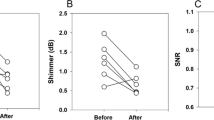Abstract
To evaluate type IIIB thyroplasty using the excised larynx bench apparatus and determine how altering vocal fold contour by performing bilateral medialization of the inferior vocal fold affects phonation. This procedure could be performed in patients for whom pitch lowering is desirable, such as female-to-male transsexuals or male patients with mutational falsetto in whom intensive voice therapy was insufficient. Aerodynamic, acoustic, and high-speed videokymographic data were collected for nine larynges at three subglottal pressure inputs for each of three conditions: normal; type IIIB thyroplasty; and combined type IIIB with modified bilateral type I thyroplasty intended to create a more rectangular glottal configuration. Each larynx served as its own control. Phonation threshold flow (p = 0.005), phonation threshold power (p = 0.031), and airflow varied across conditions with highest values for type IIIB thyroplasty and lowest for the combined procedure. Fundamental frequency was significantly different (p < 0.001), decreasing by approximately 100 Hz from control to type IIIB trials, and then by approximately 15 Hz from IIIB to combined procedure trials. Vibratory amplitudes and intrafold phase difference were highest for type IIIB trials. Addition of bilateral inferior medialization to type IIIB thyroplasty provided some further decrease in frequency, but mostly served to increase tension, reduce airflow, and produce a vibratory pattern which more closely mirrored control trials. Exploration of this combined procedure in patients may be warranted if not completely satisfied with the results from type IIIB thyroplasty alone.






Similar content being viewed by others
References
Anderson J (2007) Endoscopic laryngeal web formation for pitch elevation. J Otolaryngol 36(1):6–12
Chung D, Tsuji DH, Sennes LU, Imamura R (2007) Upper displacement of the anterior commissure: experimental study of a new phonosurgical approach to raising vocal pitch. Ann Otol Rhinol Laryngol 116(6):462–470
Gross M (1999) Pitch-raising surgery in male-to-female transsexuals. J Voice 13:246–250
Orloff LA, Mann AP, Damrose JF, Goldman SN (2006) Laser-assisted voice adjustment (LAVA) in transsexuals. Laryngoscope 116:655–660
Tucker HM (1988) Anterior commissure laryngoplasty for adjustment of vocal fold tension. Ann Otol Rhinol Laryngol 97:547–549
Remacle M, Matar N, Morsomme D, Veduyckt I, Lawson G (2011) Glottoplasty for male-to-female transsexualism: voice results. J Voice 25(1):120–123
Isshiki N, Taira T, Tanabe M (1983) Surgical alteration of vocal pitch. J Otolaryngol 12:135–154
Wendler J (1990) Vocal pitch elevation after transexualism male to female. In: Proceedings of the Union of the European Phoniatricians, Salsomaggiore, Italy
Yang CY, Palmer AD, Murray KD, Meltzer TR, Cohen JI (2002) Cricothyroid approximation to elevate vocal pitch in male-to-female transsexuals: results of surgery. Ann Otol Rhinol Laryngol 111:477–485
Wagner I, Fugain C, Monneron-Girard L, Cordier B, Chabolle F (2003) Pitch-raising surgery in fourteen male-to-female transsexuals. Laryngoscope 113:1157–1165
Leinung MC, Urizar MF, Patel N, Sood SC (2013) Endocrine treatment of transsexual persons: extensive personal experience. Endocr Pract 19:1–22
De Cuypere G, Van Hemelrijck M, Michel A, Carael B, Heylens G, Rubens R (2007) Prevalence and demography of transsexualism in Belgium. Eur Psychiatry 22:137–141
Tsoi WF (1992) Male and female transsexuals: a comparison. Singapore Med J 33:182–185
Olsson SE, Moller AR (2003) On the incidence and sex ratio of transsexualism in Sweden, 1972–2002. Arch Sex Behav 32:381–386
Landen M, Walinder J, Lundstrom B (1996) Prevalence, incidence and sex ratio of transsexualism. Acta Psychiatr Scand 93:221–223
Soderpalm E, Larsson AK, Almquist SA (2004) Evaluation of a conservative group of transsexual individuals referred for vocal intervention in the west of Sweden. Logoped Phoniatr Vocol 29:18–30
Kurz S (1993) Een poppenhuis heb ik nooit willen hebben. In: Kamprad B, SchiVels W (eds) Het verkeerde lichaam: Alles over transseksualiteit. Ambo, Baarn, pp 31–44
Van Borsel J, De Cuypere G, Rubens R, Destaerke B (2000) Voice problems in female-to-male transsexuals. Int J Lang Commun Disord 35:427–442
McNeill EJM, Wilson JA, Clark S, Deakin J (2008) Perception of voice in the transgender client. J Voice 22(6):727–733
Hancock AB, Krissinger J, Owen K (2011) Voice perceptions and quality of life of transgender people. J Voice 25(5):553–558
Dagli M, Sati I, Acar A, Stone RE Jr, Dursun G, Eryilmaz A (2008) Mutational falsetto: intervention outcomes in 45 patients. J Laryngol Otol 122:277–281
Kaplan SL (1982) Mutational falsetto. J Am Acad Child Psychiatry 21:82–85
Prathanee B (1996) Mutational falsetto voices: voice therapy. J Med Assoc Thai 79:388–394
Remacle M, Matar N, Verduyckt I, Lawson G (2010) Relaxation thyroplasty for mutational falsetto treatment. Ann Otol Rhinol Laryngol 119(2):105–109
Friedrich G, de Jong FI, Majieu HF, Benninger MS, Isshiki N (2001) Laryngeal framework surgery: a proposal for classification and nomenclature by the Phonosurgery Committee of the European Laryngological Society. Eur Arch Otorhinolaryngol 258:389–396
Isshiki N, Morita H, Okamura H, Hiramoto M (1974) Thyroplasty as a new phonosurgical technique. Acta Otolaryngol 78(5-6):451–457
Andrews M, Schmidt C (1997) Gender presentation: perceptual and acoustical analyses of voice. J Voice 11:307–313
Titze IR (2000) Principles of voice production. National Center for Voice and Speech, Iowa City
Jiang JJ, Titze IR (1993) A methodological study of hemilaryngeal phonation. Laryngoscope 103:872–882
Krausert CR, Ying D, Zhang Y, Jiang JJ (2011) Quantitative study of vibrational symmetry of injured vocal folds via digital kymography in excised canine larynges. J Speech Lang Hear Res 54(4):1022–1038
Acknowledgments
This study was funded by National Institutes of Health Grant Numbers F31 DC012495 and R01 DC008153 from the National Institute on Deafness and other Communicative Disorders.
Author information
Authors and Affiliations
Corresponding author
Rights and permissions
About this article
Cite this article
Hoffman, M.R., Devine, E.E., Remacle, M. et al. Combined type IIIB with bilateral type I thyroplasty for pitch lowering with maintenance of vocal fold tension. Eur Arch Otorhinolaryngol 271, 1621–1629 (2014). https://doi.org/10.1007/s00405-013-2798-0
Received:
Accepted:
Published:
Issue Date:
DOI: https://doi.org/10.1007/s00405-013-2798-0




